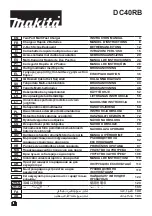
INCORPORATED
®
General Information
ITC-Series
Inverter
Page 28
8/05/17
2) There is no charge current into the battery system
3) The batteries are in a fully charged state at the beginning of the discharge cycle
4) The DC current draw from the battery does not exceed 1/3 the C rate for any length of time.
Follow the steps listed below to find the AH capacity required for your application.
Step 1:
Make a list of each appliance, its power requirement in watts, and the amount of time in hours it will be
operating between charging cycles. Note: If the appliance is rated in amperes (amps) instead of
watts, multiply the amps by the voltage (120 or 240) to get watts.
Step 2:
Calculate the watt-hours required for each appliance by multiplying the power requirement by the
operating time of that appliance.
Step 3:
Calculate the total watt-hours needed by adding together the watt-hours of each appliance.
Step 4:
Find the amp-hours consumed by dividing the total watt-hours found in step 3 by 10 for 12 volt DC
systems or by 20 for 24 volt DC systems.
Step 5:
Multiply the amp-hours consumed by 2 (for 50% depth of discharge) to get the battery amp-hour
capacity desired.
Example 1:
Follow Steps 1 through 3 (above)
Appliance
Power Rating
Operating Time
Watt-Hours Consumed
TV, VCR, Stereo
225 watts
2.5 hours
563 watt-hours
Small Refrigerator
300
3.8
1,140
Microwave
800
0.3
240
TOTALS
1,943 watt-hours
Step 4:
Amp-hours consumed = 1943 watt-hours ÷ 20 = 97.15 amp-hours for 24 a volt system.
Step 5:
The minimum battery size for this application is 2 x 97.15 = 194.3 amp-hours.
Battery and Charging System Considerations
The Battery and DC Charging System is a very important part of your inverter installation. The Battery System
is responsible for supplying all of the DC power required by the inverter. The system normally consists of the
primary charger (engine alternator or photovoltaic array), a secondary charger, if used, the battery, and other
equipment which may be used such as battery isolator diodes. The complexity of the system depends on the
way the inverter is used. In some cases, such as utility or service vehicles, the system may be as simple as the
engine alternator and the cranking battery that also powers the inverter. In most cases, additional equipment is
needed to provide additional DC power and/or protection. These systems can be grouped into two categories,
the single battery and the dual battery systems.
In the single battery system, there is one battery, which is shared for starting the engine and operating the
inverter. This is a common practice in a service vehicle where the engine runs all the time and allows the
alternator to provide continuous charging for the battery. In this case, the inverter can be connected directly to
the engine cranking battery. The most important detail of this system is the alternator output rating. The
continuous output of the alternator must be at least as much as the total DC current draw on the system. The
total DC current draw must include the inverter, warning lights, radios, engine controls, and any other device
connected to the DC system. Care should be used when operating this type of system while the engine is shut
off. The inverter will shut itself OFF for low battery but most other DC loads will not. The vehicle battery may be
also drained too low to restart the engine.
The dual battery system uses two separate batteries, one for starting the engine and operating the vehicle's
systems, and one for operating the inverter. The two batteries are usually referred to as the "cranking battery"





































